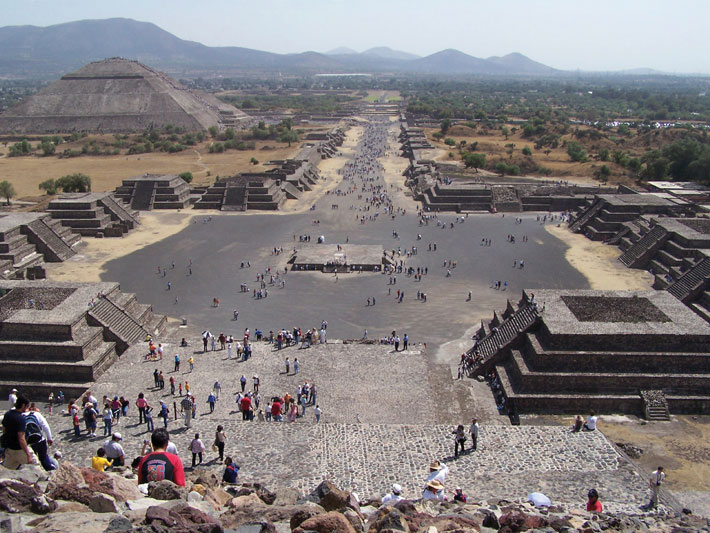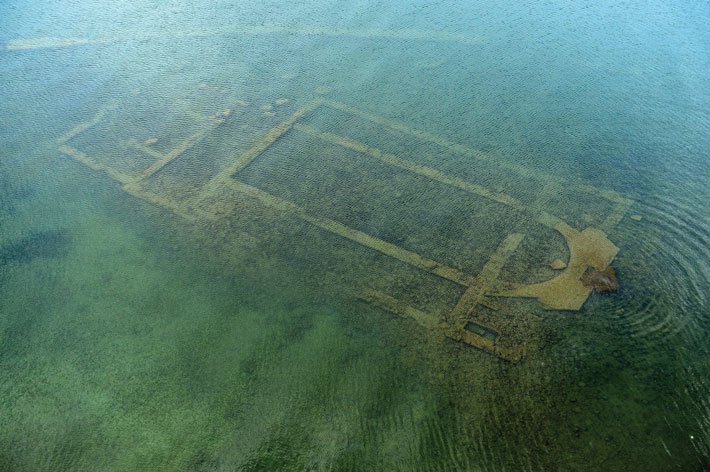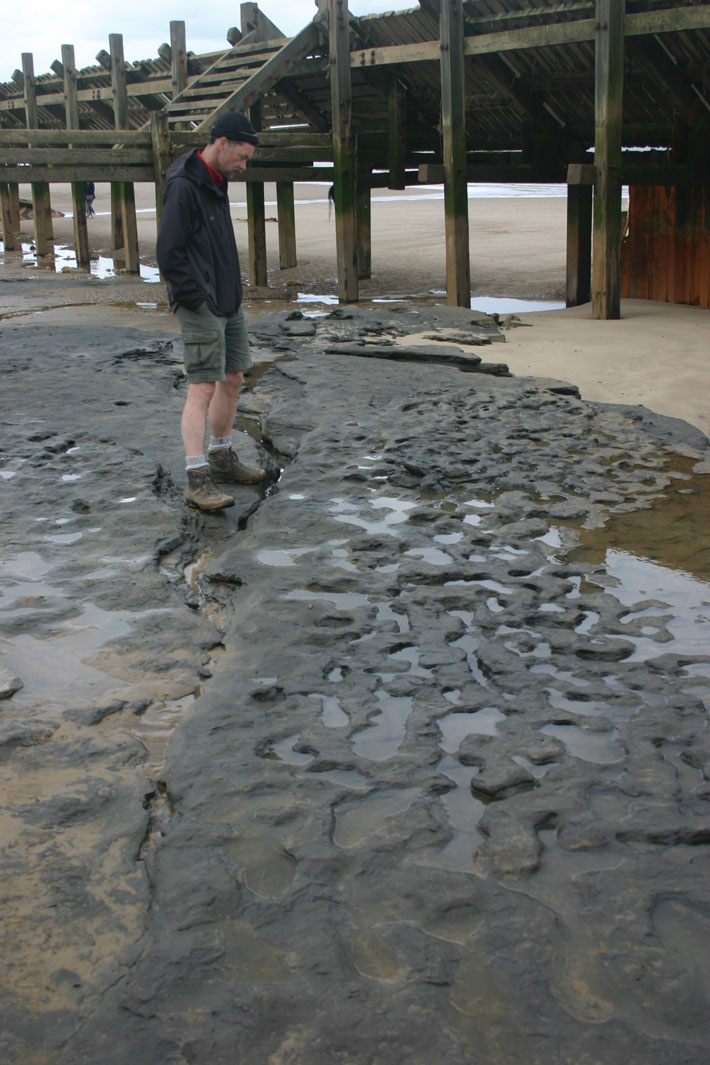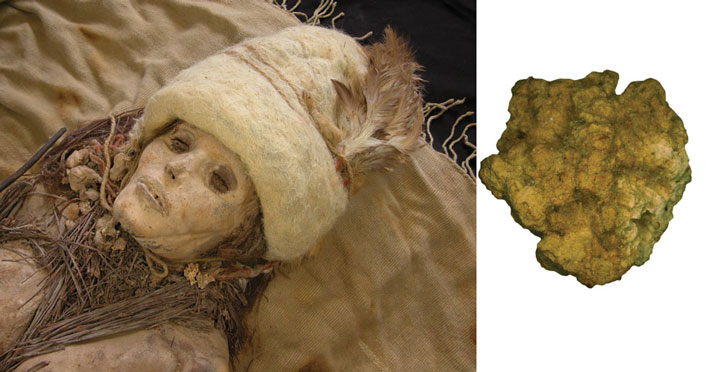From the Trenches
Big Data, Big Cities
By ERIC A. POWELL
Tuesday, April 08, 2014
 Ancient cities such as Teotihuacan may have had more in common with today’s sprawling metropolises than scholars previously imagined. University of Colorado Boulder archaeologist Scott Ortman and his colleagues have found that equations used to describe growth patterns in today’s urban centers also work when applied to early cities.
Ancient cities such as Teotihuacan may have had more in common with today’s sprawling metropolises than scholars previously imagined. University of Colorado Boulder archaeologist Scott Ortman and his colleagues have found that equations used to describe growth patterns in today’s urban centers also work when applied to early cities.
Scientists developed these mathematical models to predict how population growth affects a modern city’s population density, infrastructure, and economic production. But Ortman noticed that while the models depend on a number of variables, such as the rate of social interaction and the size of the settled area, none relied on a specific modern technology. “I thought that if this approach had any legs at all then it ought to apply to any human society, past and present,” he says.
If he is correct, then ancient settlements would have become denser in a mathematically predictable way as their populations grew. To test the theory, Ortman and his colleagues analyzed archaeological data collected during surveys of some 1,500 settlements throughout the Valley of Mexico. These ranged from small farming hamlets dating to 1500 B.C. to the Aztec capital of Tenochtitlan, which, at its height around A.D. 1500, was home to some 200,000 people. The team found that, just as with modern cities, the equations accurately predicted the relationship between settlement size and population density. According to Ortman, this insight means that archaeological data could have a role to play in modern policy debates surrounding issues such as the economics of rapid urbanization. “There’s a tendency for social scientists to think that the Industrial Revolution made all prior human history irrelevant to what’s going on now,” says Ortman. “But if the basic processes that underlie urban growth phenomena have been the same throughout time, then the archaeological record is a store of human experience that has something to offer public discourse about the issues we face as we move into the future.”
Our Lady of the Lake
By JENNIFER PINKOWSKI
Tuesday, April 08, 2014

Archaeologists were surprised by the discovery of a Byzantine basilica in just six feet of water, 60 feet from the shore of Turkey’s Lake Iznik, near the ancient city of Nicaea. Locals knew there were ruins in the lake, but scholars were unaware of the 100-by-60-foot structure until Uludag University’s Mustafa Sahin recently spotted the clear footprint of the church in an aerial photo taken by the local municipality. Sahin thinks it’s likely the church was built in the late fourth or early fifth century, less than 100 years after Nicaea hosted the First Ecumenical Council in A.D. 325, convened by the emperor Constantine to establish key doctrines for the Eastern Roman Empire.
England's Oldest Footprints
By ZACH ZORICH
Tuesday, April 08, 2014
 Nearly a million years ago, a small group of hominins walked near an estuary on the English coast 140 miles northeast of London, leaving footprints in the soft mud, which then hardened. Last summer, archaeologists working at the nearby site of Happisburgh, which dates to around the same time, discovered those footprints. They are the oldest footprints known outside of Africa—49 of them, made by at least five individuals, including some children. “One can imagine a small family group walking along the edge of the estuary looking for seaweed or shellfish,” says Nicholas Ashton of London’s Natural History Museum. Some of the footprints were lifted out of the site in a block of sediment before they could be eroded away by the tide. The sediment will be CT scanned to provide a more detailed picture of the stature and gait of the people, probably Homo antecessor, who made the prints.
Nearly a million years ago, a small group of hominins walked near an estuary on the English coast 140 miles northeast of London, leaving footprints in the soft mud, which then hardened. Last summer, archaeologists working at the nearby site of Happisburgh, which dates to around the same time, discovered those footprints. They are the oldest footprints known outside of Africa—49 of them, made by at least five individuals, including some children. “One can imagine a small family group walking along the edge of the estuary looking for seaweed or shellfish,” says Nicholas Ashton of London’s Natural History Museum. Some of the footprints were lifted out of the site in a block of sediment before they could be eroded away by the tide. The sediment will be CT scanned to provide a more detailed picture of the stature and gait of the people, probably Homo antecessor, who made the prints.
Secrets of Bronze Age Cheese Makers
By ERIC A. POWELL
Tuesday, April 08, 2014

Bronze Age mummies in China’s Taklamakan Desert were buried with the earliest known pieces of cheese affixed to their necks and chests. Chemist Andrej Shevchenko of the Max Planck Institute of Molecular Cell Biology and Genetics in Dresden came to that conclusion after analyzing several enigmatic pieces of yellow matter found on the mummies, which date to between 1980 and 1450 B.C.
Shevchenko was able to isolate proteins characteristic of cheese in the samples, and was even able to identify the kinds of yeast and bacteria used in the fermentation process. “That’s what makes this so exciting,” says Shevchenko. “We know that cheese was made as early as the sixth millennium B.C.., but this is the first evidence that shows just how people were making it.” Shevchenko points out that just 20 years ago organic matter such as these pieces of cheese might have been ignored and disposed of. “With the technology we have now, no one should throw out anything,” says Shevchenko.
Clash of the War Elephants
By ROGER ATWOOD
Tuesday, April 08, 2014

Elephants were the tanks of ancient Mediterranean warfare, commonly used for trampling and intimidating enemies. Yet there was only one battle in which African elephants and their Asian cousins are known to have met—the Battle of Raphia, in Gaza, in 217 B.C. According to the historian Polybius, it wasn’t even a contest. He writes that the African pachyderms, under the command of the Ptolemaic pharaoh of Egypt, panicked and tried to flee at the sight of the larger Asian elephants of the Seleucid army. Yet African savannah elephants are typically bigger and stronger than Asian ones. Had Polybius gotten it wrong? Modern writers have speculated that the Egyptians had African forest elephants, a smaller species than the savannah variety. Later Roman and Carthaginian armies, including Hannibal’s forces, might also have used forest elephants.
That idea has crept into modern accounts, depictions, and even video games such as Age of Empires, in which war elephants have the rounded ears and dwarfish proportions of the forest dwellers. Now geneticists have found that the species of elephant that the Egyptians had access to came from modern-day Eritrea in East Africa, and share no genetic markers with forest elephants. “The idea that they used forest elephants was not based on evidence, but it got repeated over and over,” says geneticist Alfred Roca of the University of Illinois at Urbana-Champaign. “It makes no sense. Forest elephants lived in the Congo basin, thousands of miles from the Mediterranean.” The matter of Polybius’ account remains unsettled.
Advertisement
Advertisement
IN THIS ISSUE
From the Trenches
A Brief Glimpse into Early Rome
Off the Grid
Port of the Pyramids
Hardening Brittle Bones
First American Family Tree
Recreating Nordic Grog
The Goddess' Brewer
Peeping through the Leaves
Clash of the War Elephants
England's Oldest Footprints
Secrets of Bronze Age Cheese Makers
Our Lady of the Lake
Big Data, Big Cities
Advertisement

Recent Issues
-
 May/June 2024
May/June 2024
-
 March/April 2024
March/April 2024
-
 January/February 2024
January/February 2024
-
 November/December 2023
November/December 2023
-
 September/October 2023
September/October 2023
-
 July/August 2023
July/August 2023
-
 May/June 2023
May/June 2023
-
 March/April 2023
March/April 2023
-
 January/February 2023
January/February 2023
-
 November/December 2022
November/December 2022
-
 September/October 2022
September/October 2022
-
 July/August 2022
July/August 2022
-
 May/June 2022
May/June 2022
-
 March/April 2022
March/April 2022
-
 January/February 2022
January/February 2022
-
 November/December 2021
November/December 2021
-
 September/October 2021
September/October 2021
-
 July/August 2021
July/August 2021
-
 May/June 2021
May/June 2021
-
 March/April 2021
March/April 2021
-
 January/February 2021
January/February 2021
-
 November/December 2020
November/December 2020
-
 September/October 2020
September/October 2020
-
 July/August 2020
July/August 2020
-
 May/June 2020
May/June 2020
-
 March/April 2020
March/April 2020
-
 January/February 2020
January/February 2020
-
 November/December 2019
November/December 2019
-
 September/October 2019
September/October 2019
-
 July/August 2019
July/August 2019
-
 May/June 2019
May/June 2019
-
 March/April 2019
March/April 2019
-
 January/February 2019
January/February 2019
-
 November/December 2018
November/December 2018
-
 September/October 2018
September/October 2018
-
 July/August 2018
July/August 2018
-
 May/June 2018
May/June 2018
-
 March/April 2018
March/April 2018
-
 January/February 2018
January/February 2018
-
 November/December 2017
November/December 2017
-
 September/October 2017
September/October 2017
-
 July/August 2017
July/August 2017
-
 May/June 2017
May/June 2017
-
 March/April 2017
March/April 2017
-
 January/February 2017
January/February 2017
-
 November/December 2016
November/December 2016
-
 September/October 2016
September/October 2016
-
 July/August 2016
July/August 2016
-
 May/June 2016
May/June 2016
-
 March/April 2016
March/April 2016
-
 January/February 2016
January/February 2016
-
 November/December 2015
November/December 2015
-
 September/October 2015
September/October 2015
-
 July/August 2015
July/August 2015
-
 May/June 2015
May/June 2015
-
 March/April 2015
March/April 2015
-
 January/February 2015
January/February 2015
-
 November/December 2014
November/December 2014
-
 September/October 2014
September/October 2014
-
 July/August 2014
July/August 2014
-
 May/June 2014
May/June 2014
-
 March/April 2014
March/April 2014
-
 January/February 2014
January/February 2014
-
 November/December 2013
November/December 2013
-
 September/October 2013
September/October 2013
-
 July/August 2013
July/August 2013
-
 May/June 2013
May/June 2013
-
 March/April 2013
March/April 2013
-
 January/February 2013
January/February 2013
-
 November/December 2012
November/December 2012
-
 September/October 2012
September/October 2012
-
 July/August 2012
July/August 2012
-
 May/June 2012
May/June 2012
-
 March/April 2012
March/April 2012
-
 January/February 2012
January/February 2012
-
 November/December 2011
November/December 2011
-
 September/October 2011
September/October 2011
-
 July/August 2011
July/August 2011
-
 May/June 2011
May/June 2011
-
 March/April 2011
March/April 2011
-
 January/February 2011
January/February 2011
Advertisement






